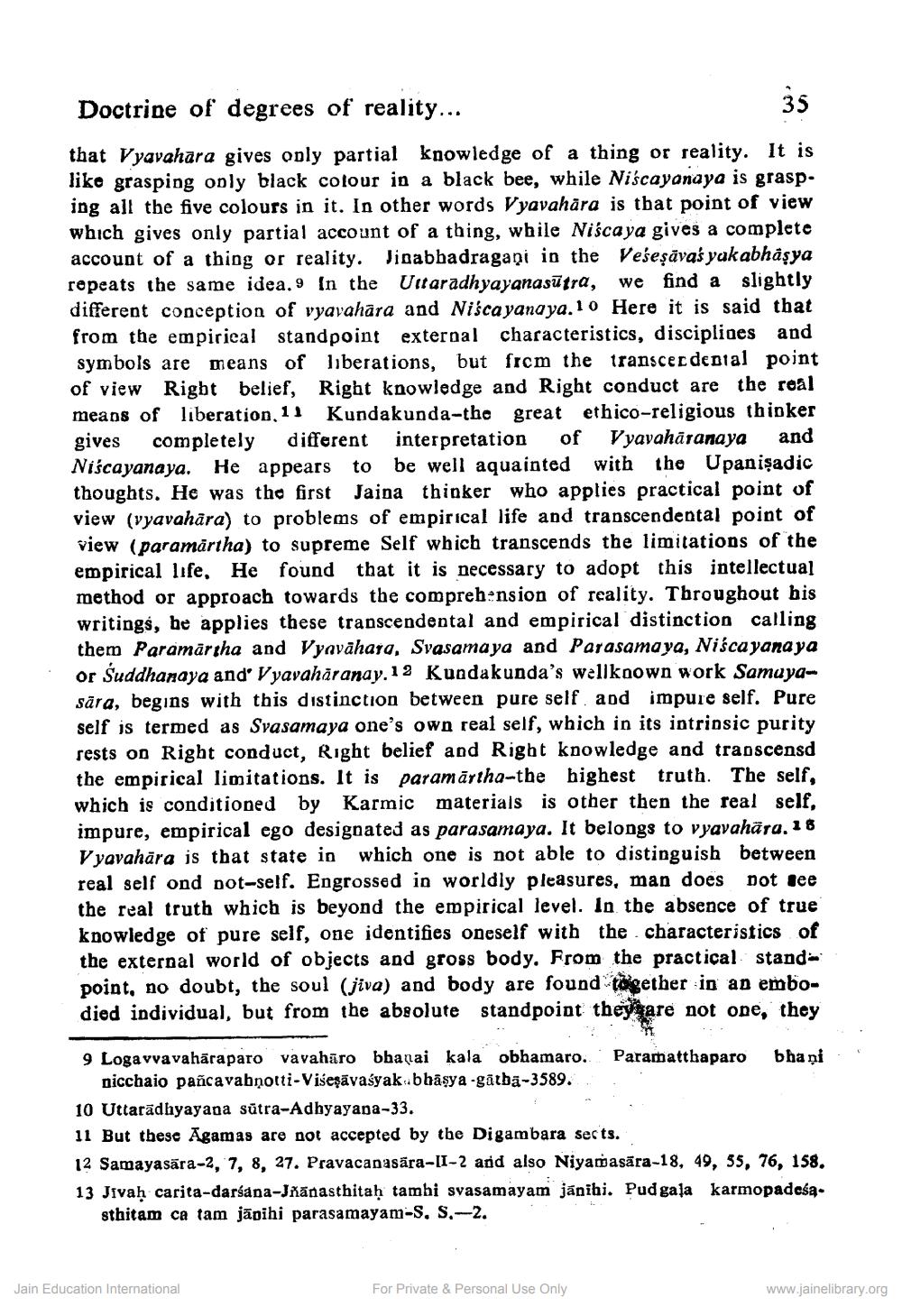________________
Doctrine of degrees of reality...
that Vyavahara gives only partial knowledge of a thing or reality. It is like grasping only black colour in a black bee, while Niscayanaya is grasp. ing all the five colours in it. In other words Vyavahāra is that point of view which gives only partial account of a thing, while Niscaya gives a complete account of a thing or reality. Jinabhadragani in the Veseşāvas yak abhâsya repeats the same idea. 9 in the Uttaradhyayanasūtra, we find a slightly different conception of vyavahāra and Niśca yanaya.10 Here it is said that from the empirical standpoint external characteristics, disciplines and symbols are means of liberations, but from the transcecdesial point of view Right belief, Right knowledge and Right conduct are the real means of liberation, 11 Kundakunda-the great ethico-religious thinker gives completely different interpretation of Vyavahāranaya and Niscayanaya. He appears to be well aquainted with the Upanişadic thoughts. He was the first Jaina thinker who applies practical point of view (vyavahāra) to problems of empirical life and transcendental point of view (paramārtha) to supreme Self which transcends the limitations of the empirical life. He found that it is necessary to adopt this intellectual method or approach towards the comprehension of reality. Throughout his writings, be applies these transcendental and empirical distinction calling them Paramartha and Vyavahara, Svasamaya and Parasamaya, Niśca yana ya or Suddhanaya and' Vyavahāranay. 12 Kundakunda's wellknown work Samayasāra, begins with this distinction between pure self and impure self. Pure self is termed as Svasamaya one's own real self, which in its intrinsic purity rests on Right conduct, Right belief and Right knowledge and transcend the empirical limitations. It is paramārtha-the highest truth. The self, which is conditioned by Karmic materials is other then the real self, impure, empirical ego designated as parasamaya. It belongs to vyavahāra. 18 Vyavahāra is that state in which one is not able to distinguish between real self ond not-self. Engrossed in worldly pleasures, man does not see the real truth which is beyond the empirical level. In the absence of true knowledge of pure self, one identifies oneself with the characteristics of the external world of objects and gross body. From the practical standa point, no doubt, the soul (jiva) and body are found together in an embodied individual, but from the absolute standpoint they are not one, they
9 Logavvavahāraparo vavahāro bharai kala obhamaro. Paramatthaparo bhaņi
nicchaio pañcavabņotti-Višeşāvaśyak bhāşya -gălbā-3589.. 10 Uttarādhyayana sūtra-Adhyayana-33. 11 But these Agamas are not accepted by the Digambara sects. 12 Samayasāra-2, 7, 8, 27. Pravacanasāra-[I-2 and also Niyamasāra-18, 49, 55, 76, 158. 13 Jivaḥ carita-darśana-Jžānasthitaḥ tambi svasamayam jānihi. Pudgala karmopadeśa.
sthitam ca tam jāpihi parasamayam-S, S.-2.
Jain Education International
For Private & Personal Use Only
www.jainelibrary.org




